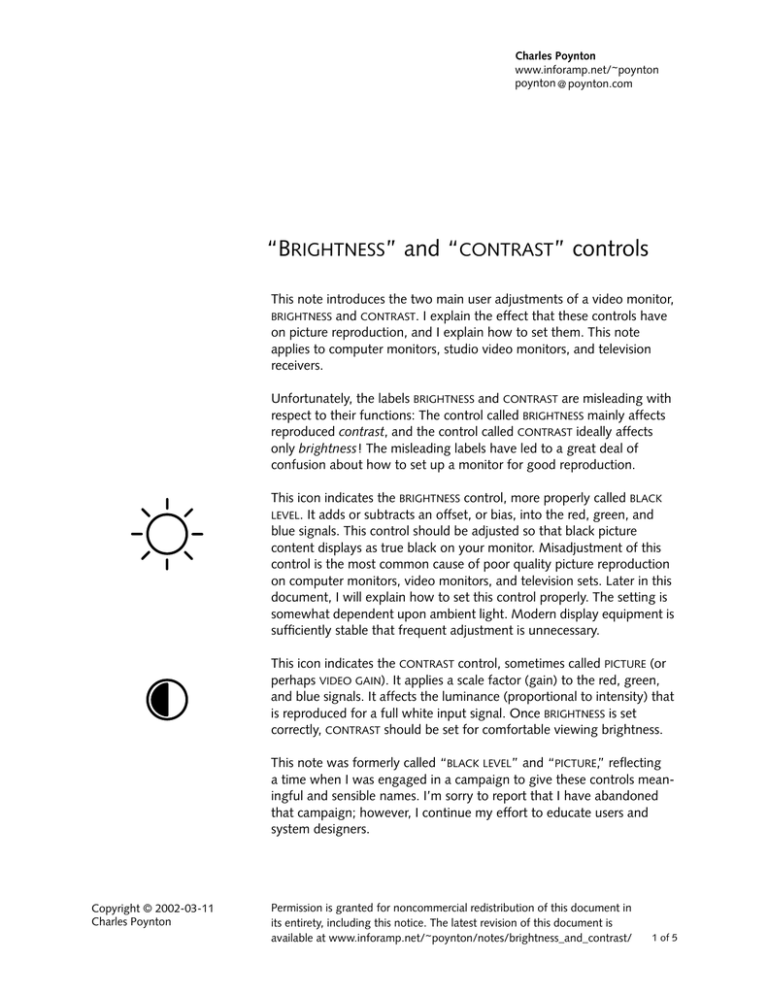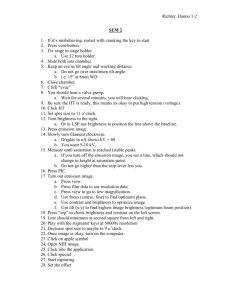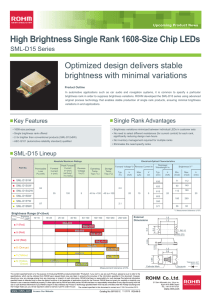“Brightness” and “Contrast” controls
advertisement

Charles Poynton www.inforamp.net/~poynton poynton @ poynton.com “BRIGHTNESS” and “CONTRAST” controls This note introduces the two main user adjustments of a video monitor, BRIGHTNESS and CONTRAST. I explain the effect that these controls have on picture reproduction, and I explain how to set them. This note applies to computer monitors, studio video monitors, and television receivers. Unfortunately, the labels BRIGHTNESS and CONTRAST are misleading with respect to their functions: The control called BRIGHTNESS mainly affects reproduced contrast, and the control called CONTRAST ideally affects only brightness ! The misleading labels have led to a great deal of confusion about how to set up a monitor for good reproduction. This icon indicates the BRIGHTNESS control, more properly called BLACK It adds or subtracts an offset, or bias, into the red, green, and blue signals. This control should be adjusted so that black picture content displays as true black on your monitor. Misadjustment of this control is the most common cause of poor quality picture reproduction on computer monitors, video monitors, and television sets. Later in this document, I will explain how to set this control properly. The setting is somewhat dependent upon ambient light. Modern display equipment is sufficiently stable that frequent adjustment is unnecessary. LEVEL. This icon indicates the CONTRAST control, sometimes called PICTURE (or perhaps VIDEO GAIN). It applies a scale factor (gain) to the red, green, and blue signals. It affects the luminance (proportional to intensity) that is reproduced for a full white input signal. Once BRIGHTNESS is set correctly, CONTRAST should be set for comfortable viewing brightness. This note was formerly called “BLACK LEVEL” and “PICTURE,” reflecting a time when I was engaged in a campaign to give these controls meaningful and sensible names. I’m sorry to report that I have abandoned that campaign; however, I continue my effort to educate users and system designers. Copyright © 2002-03-11 Charles Poynton Permission is granted for noncommercial redistribution of this document in its entirety, including this notice. The latest revision of this document is available at www.inforamp.net/~poynton/notes/brightness_and_contrast/ 1 of 5 2 “BRIGHTNESS” AND “CONTRAST” CONTROLS contrast (or picture) Luminance Figure 1 CONTRAST control determines the luminance (proportional to intensity) produced for white, with intermediate values toward black being scaled appropriately. In a well-designed monitor, adjusting CONTRAST maintains the correct black setting, indicated in this graph by the fact that zero input signal produces zero luminance at any setting. Video signal Luminance BLACK WHITE Gray Pedestal Video signal BLACK WHITE Luminance Figure 3 BRIGHTNESS control is set correctly when the black video signal level is placed precisely at the point of minimum perceptible light output at the display. In a perfectly dark viewing environment, the reference black signal would produce zero luminance; however, in practice the setting is dependent upon ambient light in the viewing environment. Video signal WHITE Figure 4 BRIGHTNESS control set too low causes a range of input signal levels near black to be reproduced indistinguishably as black. Black image content is said to be “crushed” or “swallowed.” A cinematographer might refer to this situation as “lack of details in the shadows,” however, all information in the shadows is lost, not just the details. Luminance BLACK Lost signal BLACK Figure 2 BRIGHTNESS control has the effect of sliding the black-to-white video signal scale left and right along the power function of the display. Here, brightness is set too high; a certain amount of luminance is produced at zero video signal level. No video signal can cause true black to be displayed: The picture content rides on an overall pedestal of gray, and contrast ratio is degraded. Video signal WHITE “BRIGHTNESS” AND “CONTRAST” CONTROLS 3 LCD displays have controls labeled BRIGHTNESS and CONTRAST, but these controls have different functions than the like-named controls of a CRT display. In an LCD, the BRIGHTNESS control, or the control with that icon, typically alters the backlight luminance, thereby effecting control over what in a CRT would be adjusted by CONTRAST. The remainder of this note applies just to CRTs. I will explain the controls with reference to Figures 1 through 2 opposite. In the graphs, the x-axis represents the video signal input to a monitor, and the y-axis shows the luminance produced at the face of the screen. No matter what the BRIGHTNESS and CONTRAST settings, the monitor imposes a nonlinear relationship from signal to luminance (or loosely, intensity). Figure 1 shows the effect of the CONTRAST control; Figure 3 shows the effect of BRIGHTNESS. Contrast ratio is the ratio of luminance between the brightest white that can be produced and the darkest black that can be produced. Contrast ratio is a major determinant of perceived picture quality: If a picture has high contrast ratio, you will judge it to be sharper than a picture with lower contrast ratio, even if the lower contrast picture has substantially more measurable resolution. To achieve good reproduced contrast ratio and good picture quality, it is important to set black level accurately. The most common problem with picture reproduction on video and computer monitors is misadjustment of black level. Figure 2 shows what happens if BRIGHTNESS is set too high. Figure 4 shows what happens if BRIGHTNESS is set too low. Monitor Adjustment A monitor is properly adjusted when it meets two conditions. First, a black input signal – in desktop computing, RGB code [0, 0, 0] – should produce true black, so as to maximize the contrast ratio of the display. Second, a white input signal – in desktop computing, RGB code [255, 255, 255] – should produce the desired luminance. The easiest way to adjust a monitor is to perform the following four steps in sequence: (1) turn the CONTRAST control to minimum; (2) display a black picture; (3) adjust the BRIGHTNESS control to reproduce black correctly; then (4) adjust the CONTRAST control to display the brightness level that you desire. I’ll detail these steps in a moment. On a monitor or television receiver with the traditional names for the controls, first adjust BRIGHTNESS to obtain a true black that will maximize contrast, then adjust CONTRAST for the appropriate brightness. You can now understand why the modern names for these controls are BLACK LEVEL and PICTURE, and why it’s sensible to use icons instead of names to identify these controls. Unfortunately, the traditional names have been inherited by modern devices such as scanners and image editing programs, so you may have to remember that their functions are opposite to their names. 4 “BRIGHTNESS” AND “CONTRAST” CONTROLS Step 1: Set CONTRAST to minimum The first step in monitor adjustment is to set CONTRAST to its minimum setting. Some so-called “smart” television sets have automatic black level circuits that alter black level as a function of picture content. These circuits should be defeated if possible, both for monitor adjustment and for high-quality viewing. Step 2: Display black Display an image that is predominantly or totally black, perhaps by using a screen-saver. (In a well designed monitor, setting CONTRAST to its minimum will cause the visible raster to disappear.) Television stations and networks fade to black between commercials. If you are adjusting a television receiver, you can use this “black” to set black level. Make it quick, though! A television station never transmits black for more than a fraction of a second. If you find a colorbar test signal, its lower right corner contains true black. Black level should not vary from station to station. Step 3: Adjust BRIGHTNESS The third step in monitor adjustment is to adjust the BRIGHTNESS control to a balance point or threshold, low enough that a black area of the picture emits no light, but high enough that setting the control any higher would cause the area to become a dark gray. Computer monitors are generally underscanned: the extreme margins of the screen have no picture content. A rough setting for black level can be found by making the underscanned margins as black as possible. However if your framebuffer has nonzero setup (or EIA-343-A levels) then this method is inaccurate. Using black picture content, instead of the margins, always assures an accurate setting. When you set BRIGHTNESS to its minimum, your monitor may display a shade of dark gray instead of black. This indicates an internal misadjustment: Ask a service technician to make the necessary internal adjustment. When your monitor’s BRIGHTNESS is set near its threshold, your monitor may display a dark color instead of a dark gray. This indicates that your monitor is mistracking: The internal screen or cutoff calibration of one or two of its guns is set incorrectly. Ask a service technician to repair this problem. Step 4: Adjust CONTRAST Once black level is set correctly, CONTRAST can be adjusted so that a white signal produces the appropriate level of luminance. In a television studio environment there are standards for absolute luminance. Outside that environment there is no “proper” setting of this control; it depends entirely upon your preference. Resist the temptation to set your monitor too bright. Excessive brightness has a number of disadvantages. First, your sensitivity to flicker “BRIGHTNESS” AND “CONTRAST” CONTROLS 5 increases as brightness increases, so setting your monitor too bright is likely to increase your perception of flicker. Second, a number of phenomena act to scatter light onto the face of the screen, and the higher the brightness of bright areas of the picture, the more light is scattered into the dark areas. This scattered light reduces the contrast ratio – hence the perceived quality – of the picture. Third, operation at high brightness tends to defocus the electron beam of the CRT, resulting in poor sharpness. Some poorly designed monitors exhibit variation in black level upon adjustment of CONTRAST. If your monitor suffers from interaction, after adjusting CONTRAST you may have to go back and tweak BRIGHTNESS. It may even be necessary to iterate between the two controls a few times in order to set the combination that both reproduces black correctly and reproduces white at the brightness you desire. A studio video color bar signal includes a picture line-up generator (PLUGE) element at the bottom of the screen, which comprises a reference black bar with two small variations: an excursion slightly blacker than black, and an excursion slightly lighter than black. Black level is correctly set when the blacker-then-black element is indistinguishable from black, but the lighter-than-black element is just barely visible. Further Reading For details of the nonlinear transfer function (“gamma”) of a video monitor, see my Gamma FAQ available on the Internet at <http://www.inforamp.net/~poynton/GammaFAQ.html>. Poynton, Charles, A Technical Introduction to Digital Video (New York: Wiley, 1996). Poynton, Charles, Digital Video and HDTV Algorithms and Interfaces (San Francisco: Morgan Kaufmann, 2002). In press. For even more detail concerning nonlinear transfer functions, consult the Gamma chapter in my book. My forthcoming book dedicates a chapter to the technical aspects of BRIGHTNESS and CONTRAST controls.



